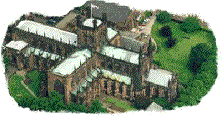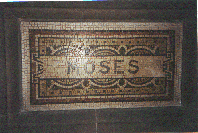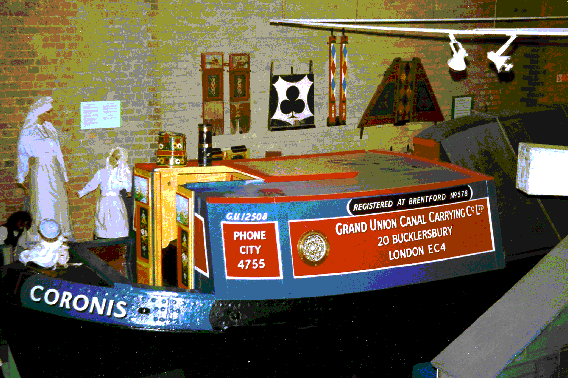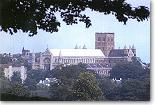Copyright © University of Cambridge. All rights reserved.
'Meaningful Maths Trails' printed from https://nrich.maths.org/
Show menu
Please see our more recent article, Maths Trails - Encouraging Purposeful Outdoor Learning
Routes and pathways have an obvious connection with trails: trails take a route around a particular place following different clues or rules. Of course we are most interested in Maths Trails and they are becoming increasingly popular at different historic and natural sites that are used for school visits.
Maths Trails offer huge potential for learning experiences at all ages. The scope is endless and trails can be tailored to fit into certain topics, or include a whole range. It is important to be critical when constructing a trail or using one that already exists. Are the pupils really challenged? We should be aiming to improve their mathematical thinking, not just their observational skills. The
questions should provide opportunities for children to explore and develop strategies for solving a variety of problems. The change of environment can help to make them feel less threatened and perhaps more willing to offer suggestions. Managed in the right way, trails present a golden opportunity to enrich mathematical talk. This can be done at all stages of the trail - in the classroom
preparation beforehand, doing the trail itself and during follow-up work.
It may sound daunting to begin to compile your own Maths trail, but don't do it alone! Once done, the trail will be easily transferable to other classes of the same age and won't require much updating in future years. By liaising with colleagues it could also be adapted for other year groups. At a recent Masterclass meeting, one of the groups mentioned how successful a trail around the school had
been. The organiser, Avril Crack, describes below how she went about planning and setting up the trail for Maths Mates in Sandy, Bedfordshire. It is well worth a read and should encourage you to have a go!
Avril attached the trail and the question sheet that the children used to write their answers on. They would be easy to adapt to another school. Click here to have a look! (Questions to maths mates trail , Answer sheet)
If you're planning a school visit it is worth finding out which local attractions already have their own Maths trail. We have tried out two ourselves - one at The London Canal Museum and one at Chester Cathedral.
Chester Cathedral, Cheshire


The trails for KS1 are designed for a small group of pupils accompanied by an adult to assist with reading. One trail is based entirely on shape, the other includes a range of mathematical topics including estimation, number and measuring, in addition to shape. There is some overlap between the two so your choice would depend on the aims you had in mind.
Can you think of a way to estimate the number of mosaic pieces used in this picture?
The ideas used in the KS2 trail are similar to that of KS1 but obviously extended. Children are encouraged to reflect on calculation methods rather than simply arriving at an answer. Again measuring, estimation, shape and number material are included, but also identification of patterns, which could lead into emergent algebra back in the classroom.
Comprehensive Teacher Resource Packs are available which give an overview of the topics covered on the trails, along with any pre-visit knowledge required and suggested follow-up work.
Not only does the cathedral provide a wonderful setting to explore maths, but it gives the children an opportunity to look hard at their surroundings and learn about the different parts of a church.
Further information can be obtained from the main website: www.chestercathedral.com
London Canal Museum

The museum is an interactive hands-on centre for learning about canals. The museum was once an ice warehouse and ice was stored in huge ice wells after it had been brought to the canal dock from Norway. The ice was sold to customers and delivered by horse and cart.
The museum has a good maths trail. It is unusual as it asks some fairly tricky questions and could lead to some interesting follow-up work in school. There are fourteen activity sheets, half for upper Key Stage 1/ lower Key Stage 2 and half for upper Key Stage 2. They are in pairs on the same topic ranging from 'At home in a narrowboat' through 'Coal' to 'Symmetry'.
School parties should book in advance and the museum can provide books and tape measures. More information can be found by contacting the education officer via the website.
Other Venues
Below we list just a small selection of venues which offer Maths trails. Thank you to all who sent in details! We are sure you'll agree that the variety of locations is quite remarkable.

Wilderness Wood, Hadlow Down, Nr Uckfield, E Sussex
Wilderness Wood is a fantstic working woodland in the High Weald Area of Outstanding Natural Beauty. Anne and Chris Yarrow, the owners, have been offering school visits for 25 years, and the site is now well geared to receiving pupils of all ages, from pre-school to university. A special maths trail has been devised and was updated in 2005 by a group of local primary school teachers. Aimed at years 5 and 6, the trail is a series of zones with activities to complete. The trail is structured so that groups can do all or parts of the trail, as time and ability allow and it is designed to be used by the school's own staff and helpers. The woodland setting is very much a part of the activities. For example, patterns in ferns are investigated, diameters and heights of trees are measured, and problems based on the wood products the woodland sells are set. The activities are fairly short, to keep the pupils moving around the woodland. They are relevant - maths problems that are faced by the staff of the woodland on a daily basis.
Winchester Cathedral, Winchester, Hampshire
KS2 trail
https://www.winchester-cathedral.org.uk

St Alban's Cathedral, St Albans, Herts
KS1 and KS2 Trails on offer
Contact them via Website:www.stalbanscathedral.org
Preston Hall Museum, Yarn Road, Stockton-on-Tees
Trails available for KS1 and KS2
Website: www.stockton-bc.gov.uk/visit/visit-main-preston-hall.htm

Activities suitable for both Key Stages
Tel: 01229 894444
Website: www.dockmuseum.org.uk
Chester Cathedral, Chester, Cheshire
Two trails for KS1, one for KS2
Contact the Education Officer, on 01244 500957
Website: www.chestercathedral.org.uk
London Canal Museum, New Wharf Road, Kings Cross, London
Activities suitable for upper KS1 and KS2
Contact the Education Officer on 0207 713 0836
- Make sure you have enough adult supervision while the pupils are doing the trail, perhaps as "check points" as Avril did, or to actually accompany groups.
- This is an ideal opportunity to involve parents/carers in their child's maths.
- Why not ask the children to make up a trail themselves, perhaps for younger pupils in the school? With discussion and guidance this could be a worthwhile follow-up activity.
